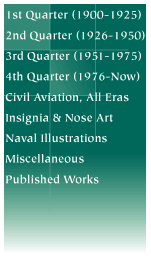
![]()

Yellow Nosed Bf109Es
By Chris Banyai-Riepl
Here's a selection of yellow-nosed Bf109Es to gaze at. All are based from black and white photos and as such are open to interpretation. Each one is based off of a specific photo or set of photos. As always, additional information is greatly appreciated.
These illustrations are only a few of the over 300 profiles done for my Bf 109 book. Visit the Published Works page for more information on this title.

Bf109E-4, 3./JG1, De Koy, Early 1941
This Bf109 shows to good effect the early paint scheme of RLM71/02/65, with a hard demarcation line between the upper camouflage and lower. No mottling is present.

Bf109E-3, 6./JG51, Autumn 1940
Staffelkapitän Josef "Pips" Priller
Pips Priller had a rather long career in the Luftwaffe and became one of the top aces of the Second World War. This Bf109E is from early in his career and is marked from the time of his receiving the Ritterkreuz for twenty victories (seen in white on the tail). The plane is finished in RLM71/02/65 with dense mottling on the fuselage sides consisting of RLM70, 71, and 02. The mottling even covered part of the JG51 badge on the rear fuselage.

Bf109E-1, 7./JG52, Balkans, 1941
After the Battle of Britain, many of the early variants of the Bf109 found their way to lesser fronts, such as this one in the Balkans. The camouflage is thought to be the original RLM70/71/65, but it could have been repainted in 71/02. Somewhat dense mottling is apparent and likely consisted of a mix of RLM70, 71, and 02.

Bf109E-4, W.Nr. 4148, II./JG27, 1940
Hpt. Wolfgang Lippert
The dancing bear of II./JG27 is on the yellow nose of this Bf109E flown by Hpt. Lippert. The finish is thought to be RLM 71/02/65 with a light mottling of RLM 71 and RLM 02 on the fuselage sides. Lippert's kill markings on the tail consist of a black bar with roundels centered, denoting the country of each kill.

Bf109E-4, W.Nr. 5344, JG2, November 1940
Major Helmut Wick, Kommodore JG2
One of the most famous Bf109s from the Battle of Britain, this plane saw many different changes in its lifetime. Major Wick was quickly on his way to becoming one of the best known fighter pilots of the war when he was shot down by a Spitfire in late 1940. This profile shows his plane at the end, with 54 kill markings on the rudder and the Kommodore chevron markings on the fuselage. JG2 used an interesting scheme of brush stippling instead of sprayed mottling. The base scheme is thought to be RLM71/02/65, with the stippling in either RLM71 or RLM70. The double chevron markings from when Major Wick was Kommandeur of I./JG2 have been painted out, most likely with RLM70.

Bf109E-4, 2./JG51, late 1940
This Bf109 was flown by an unknown pilot who racked up a tally of twelve victory bars on the rudder. The finish appears to be RLM02 and RLM71 over RLM65, with mottling of both 02 and 71 on the fuselage sides.